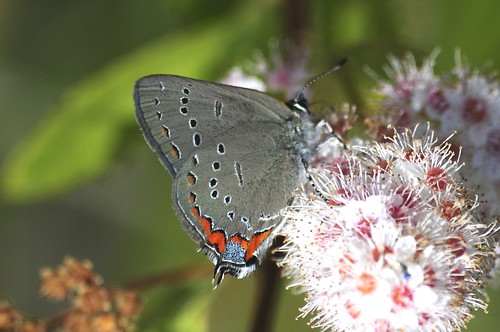Acadian hairstreak
(Satyrium acadica)
Conservation • Description • Habitat • Ecology • Distribution • Taxonomy
Conservation Status |
|
|||||||
| IUCN Red List | not listed |
|||||||
| NatureServe | N5 - Secure S4 - Apparently Secure |
|||||||
| Minnesota | not listed |
|||||||
Description |
||
Acadian hairstreak is a medium-sized, gossamer-winged butterfly. It occurs in the northern United States from Maine to New Jersey, west to Montana and Colorado, and in southern Canada from Prince Edward Island to Alberta. Larvae feed on the leaves of shrubby willows. Adults are found from late June to early August in shrubby, usually wet areas, including meadows, marshes, stream sides, and roadside ditches. They feed on flower nectar. Adults have a 1 3⁄16″ to 1¼″ (30 to 32 mm) wingspan. The upper side of the wings are rarely seen because this butterfly perches with wings closed and is rarely seen from above. Like other hairstreaks, the hindwing has two tails near the tip. The shorter, upper tail is very short and often does not look at all like a tail. The underside of both wings is light gray. Each wing has an elongated, dash-like cell end bar, a curved postmedial row of round spots, and a submarginal row of orange crescent-shaped spots. The cell end bar and postmedial spots are black and are circled with white. The inner edge of each submarginal spot is capped with an inner black and outer white border. Across both wings the submarginal spots become progressively smaller and with less orange as they approach the tip of the forewing. On the hindwing, there is a large, light blue spot capped with orange below the tail, and a long, narrow, orange spot on the inner margin at the anal angle. The blue spot extends nearly to the postmedial band. The eyes are black. The antennae are striped black-and-white and have an orange-tipped club. |
||
Size |
||
Wingspan: 1 3⁄16″ to 1¼″ (30 to 32 mm) |
||
Similar Species |
||
Habitat and Hosts |
||
Shrubby, usually wet areas, including meadows, marshes, stream sides, and roadside ditches. Shrubby willows. |
||
Ecology |
||
Season |
||
One generation per year: late June to early August |
||
Behavior |
||
Adults perch with their wings closed above their body. They are rarely seen with their wings spread. |
||
Life Cycle |
||
Eggs overwinter |
||
Larva Food |
||
Leaves of willows |
||
Adult Food |
||
Flower nectar |
||
Distribution |
||||
|
Sources |
|||
| 7/27/2022 | ||||
Occurrence |
||||
|
||||
Taxonomy |
|||
Order |
Lepidoptera (Butterflies and Moths) | ||
Superfamily |
Papilionoidea (Butterflies) | ||
Family |
Lycaenidae (gossamer-winged butterflies) | ||
Subfamily |
Theclinae (hairstreaks) | ||
Tribe |
Eumaeini | ||
| Subtribe | Eumaeina | ||
Genus |
Satyrium (satyrid hairstreaks) | ||
| Subgenus | Satyrium | ||
Subordinate Taxa |
|||
Acadian hairstreak (Satyrium acadica acadica) Acadian hairstreak (Satyrium acadica coolinensis) Montana hairstreak (Satyrium acadica montanensis) |
|||
Three subspecies have been described based on size and overall darkness. However, the characters used to separate them intergrade throughout the range of the species. Most sources consider the subspecies invalid. |
|||
Synonyms |
|||
Satyrium acadicum |
|||
Common Names |
|||
Acadian hairstreak |
|||
Glossary
Anal angle
In insects: The angle at the corner of a wing formed where the outer and inner margins meet.
Gender Conformity
According to the The International Code of Zoological Nomenclature (ICZN), the gender of a species name must conform to the gender of the genus name.
There are no persons alive today who we can consult whose native language is Latin. Few taxonomists know the correct way to use Latin to properly assign a gender to a proposed species name. Species are sometimes transferred to a different genus with a different gender. For these reasons, some butterflies have species names that do not conform to the gender of the genus name.
Satyrium acadica is one of those species. The correct, gender conforming name should be Satyrium acadicum.
The trend among butterfly workers worldwide has been to ignore the ICZN rule and keep the original spellings. BugGuide.net rejects this trend and uses the binomial name Satyrium acadicum. virtually every other source uses the original spelling, Satyrium acadica.
Visitor Photos |
|||||
Share your photo of this insect. |
|||||
| This button not working for you? Simply email us at info@MinnesotaSeasons.com. Attach one or more photos and, if you like, a caption. |
|||||
Terry O'Brien |
|||||
On milkweed near willows, among skippers. |
|||||
 |
|||||
MinnesotaSeasons.com Photos |
|||||
|
|||||

Visitor Videos |
|||
Share your video of this insect. |
|||
| This button not working for you? Simply email us at info@MinnesotaSeasons.com. Attach a video, a YouTube link, or a cloud storage link. |
|||
Other Videos |
|||

Created: 7/27/2022
Last Updated:




